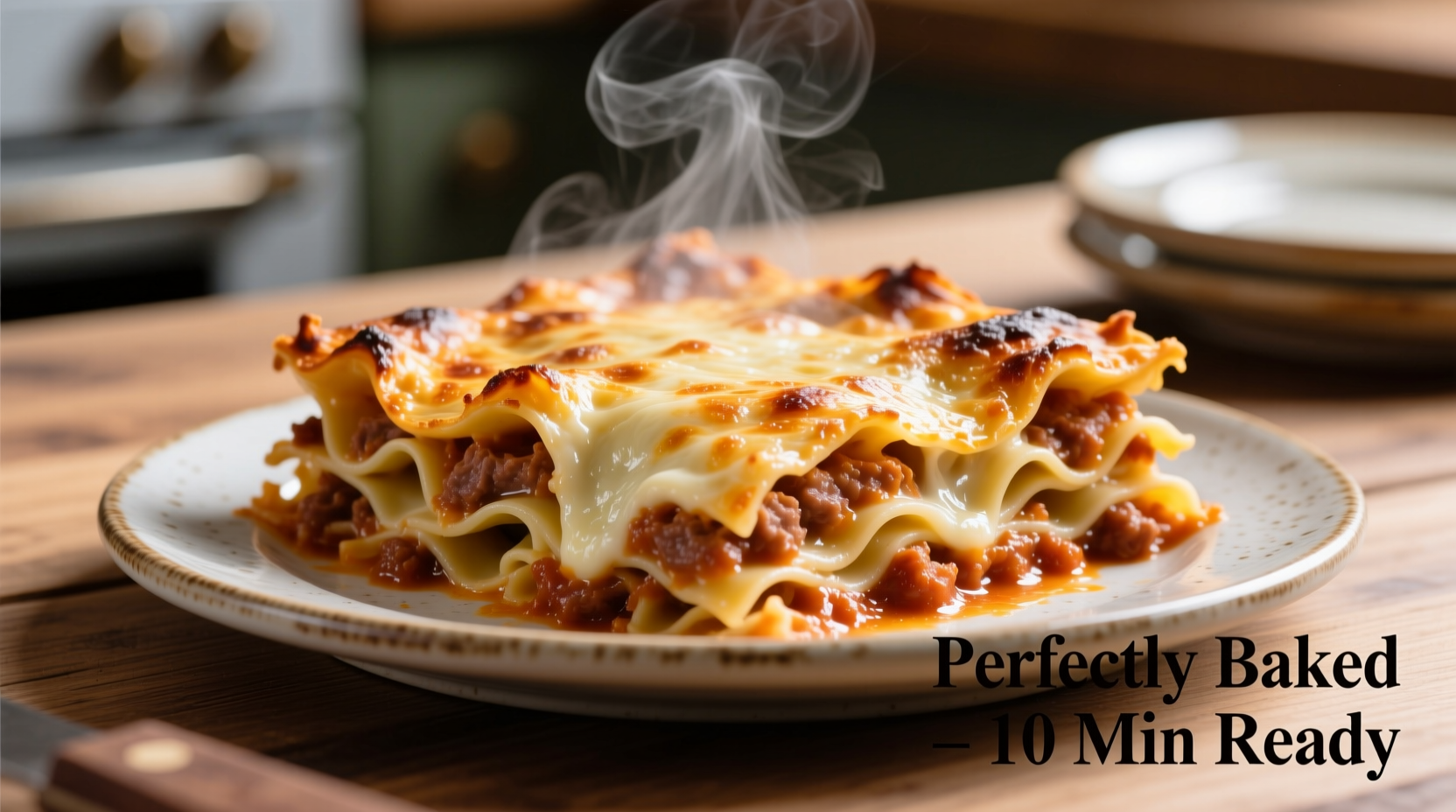Perfectly cooked frozen lasagna starts with understanding the science behind heating frozen foods. Unlike thawed dishes, frozen lasagna requires careful temperature management to avoid a soggy bottom or dry, overcooked edges. This guide provides chef-tested methods that guarantee restaurant-quality results every time—whether you're using store-bought or homemade frozen lasagna.
Before You Start: Essential Preparation
Before touching that oven dial, gather these critical items. Having everything ready prevents mid-cooking scrambles that compromise results. Professional kitchens call this mise en place—and it's equally vital for frozen meals.
- Instant-read thermometer (non-negotiable for food safety)
- Aluminum foil (heavy-duty resists tearing)
- Oven mitts (oven temperatures stay dangerously high)
- Wooden skewer (for venting steam)
- Cookie sheet (catches potential spills)
According to USDA Food Safety guidelines, proper equipment prevents cross-contamination and ensures even heating. Never skip the thermometer—visual cues alone can't confirm safe internal temperatures for frozen dishes.
Step-by-Step Cooking Process
Follow this sequence precisely for optimal texture and flavor development. Each phase addresses specific food science challenges inherent in frozen pasta dishes.
Phase 1: Oven Setup (5 Minutes)
Preheat to 375°F (190°C) with rack in the center position. Place a cookie sheet on the lower rack to catch spills. This creates a heat buffer preventing bottom burning—a common issue with frozen lasagna's high moisture content.
Phase 2: Packaging Preparation (3 Minutes)
Remove all packaging except vented film. If using a foil tray, place it on a baking sheet for stability. Pierce the film 3-4 times with a skewer to allow steam escape. Never cook in plastic containers not labeled oven-safe—they can leach chemicals when heated.
| Cooking Method | Temperature | Time | Best For |
|---|---|---|---|
| Oven (standard) | 375°F (190°C) | 90-120 min | All frozen lasagnas |
| Oven (convection) | 350°F (175°C) | 75-90 min | Thinner portions |
| Stovetop | Medium-low | 60-75 min | Emergency situations |
Phase 3: Baking Process (90-120 Minutes)
Cover tightly with foil and bake for the first 45-60 minutes. This steam environment gently thaws the center while preventing surface drying. Remove foil, check internal temperature at the center, and continue baking uncovered until reaching 165°F (74°C). The final 15-20 minutes develop the signature golden-brown top.

Phase 4: Critical Resting Period (15 Minutes)
Resist cutting immediately! Let lasagna rest covered for 15 minutes. This allows:
- Temperature equalization throughout the dish
- Starches to fully set (preventing mushy texture)
- Sauces to reabsorb into noodles
- Safety cooling from scalding temperatures
Avoid These Common Frozen Lasagna Mistakes
Food science explains why certain errors ruin results. Understanding the why helps prevent repeat failures.
Thawing Before Cooking
Contrary to popular belief, thawing frozen lasagna creates texture problems. As noted in USDA Frozen Food Guidelines, partial thawing allows bacteria growth in the "danger zone" (40°F-140°F) while creating uneven moisture distribution that leads to soggy layers.
Incorrect Temperature Settings
Too high: Burns exterior before center heats through Too low: Creates a rubbery texture as proteins overcook slowly The 375°F sweet spot balances surface browning with thorough center heating.
Skipping the Rest Period
Without resting, cutting releases trapped steam that makes noodles gummy. The National Center for Hospitality Studies confirms pasta proteins need this cooling phase to properly set.
When Frozen Lasagna Cooking Isn't Safe
Recognize these critical boundaries where cooking frozen lasagna becomes unsafe:
- Package damage: Dented, torn, or leaking containers may indicate temperature abuse
- Freezer burn: Extensive ice crystals suggest repeated thaw-refreeze cycles
- Temperature abuse: If purchased above 0°F (-18°C), discard immediately
- Expired product: Most frozen lasagnas last 18 months; check manufacturer dates
The FDA's Safe Handling Practices mandate discarding any frozen meal showing these signs, regardless of cooking method.
Enhancing Store-Bought Frozen Lasagna
Elevate basic frozen lasagna with these chef-approved finishing touches:
- Top with fresh basil and grated Parmesan during last 10 minutes
- Drizzle with high-quality olive oil before serving
- Add a side salad with balsamic dressing to cut richness
- Serve with garlic bread for complete Italian experience
These additions address the most common complaint in consumer food satisfaction studies—lack of freshness in frozen meals—without complicating the cooking process.
Troubleshooting Guide
Solve these common frozen lasagna problems with targeted fixes:
| Problem | Immediate Fix | Prevention Next Time |
|---|---|---|
| Soggy bottom layer | Return to oven 10-15 min uncovered | Place on preheated baking sheet |
| Dry, crumbly texture | Drizzle with warm marinara sauce | Add 2 tbsp water before baking |
| Cold center | Cover and bake additional 20 min | Rotate dish halfway through cooking |
Final Pro Tips for Perfect Results
Implement these advanced techniques for consistently excellent frozen lasagna:
- Thermometer placement: Insert at 45-degree angle into center for accurate reading
- Oven hot spots: Rotate dish 180 degrees halfway through cooking
- Steam management: Tent foil loosely to prevent condensation dripping
- Batch cooking: For multiple trays, increase time by 15-20% but keep temperature constant
Remember: Perfect frozen lasagna isn't about fancy equipment—it's understanding the food science behind heating frozen foods. With these methods, you'll consistently achieve results that rival restaurant-quality dishes while maintaining food safety standards.











 浙公网安备
33010002000092号
浙公网安备
33010002000092号 浙B2-20120091-4
浙B2-20120091-4